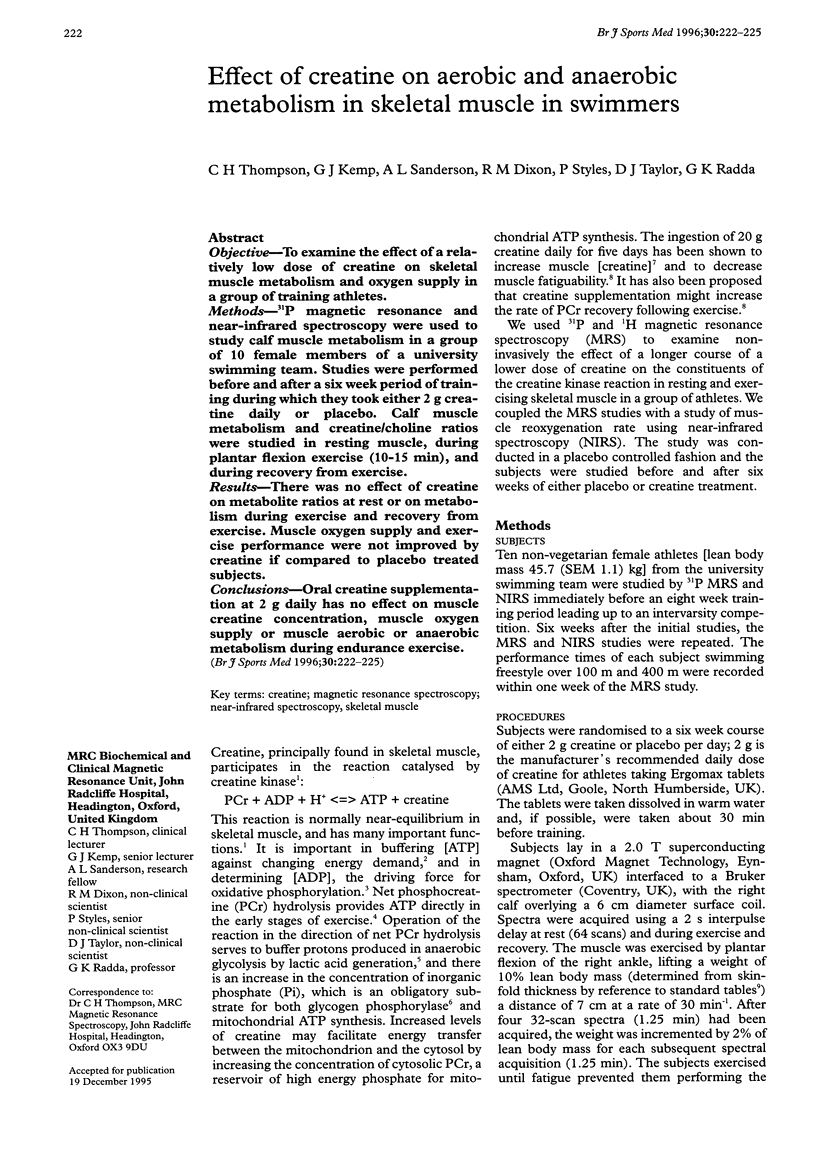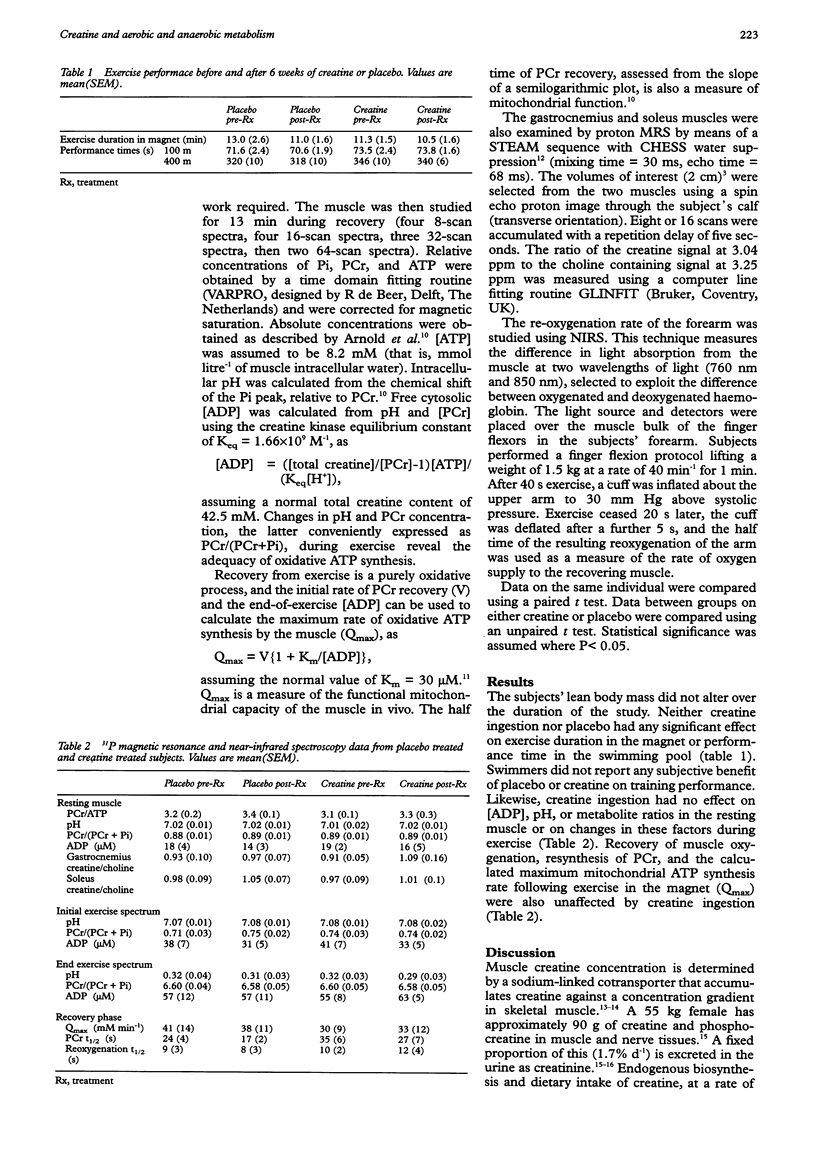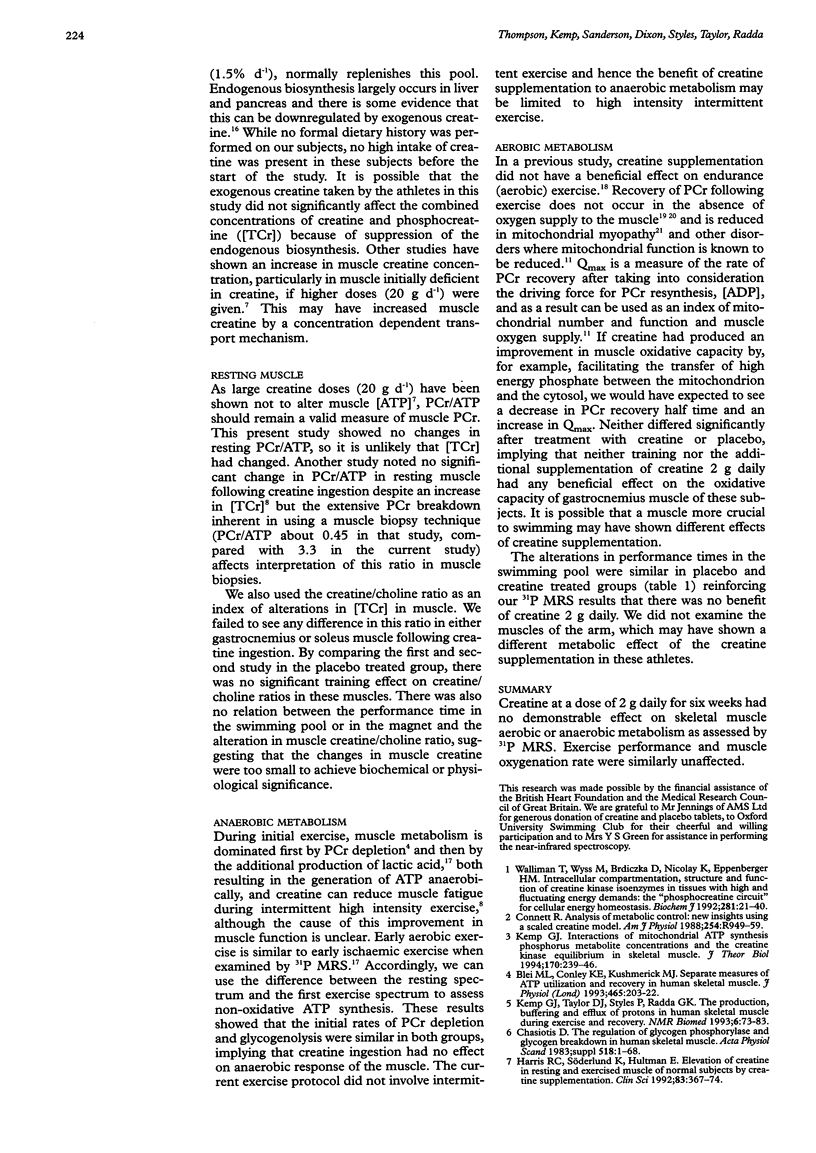Abstract
OBJECTIVE: To examine the effect of a relatively low dose of creatine on skeletal muscle metabolism and oxygen supply in a group of training athletes. METHODS: 31P magnetic resonance and near-infrared spectroscopy were used to study calf muscle metabolism in a group of 10 female members of a university swimming team. Studies were performed before and after a six week period of training during which they took either 2 g creatine daily or placebo. Calf muscle metabolism and creatine/choline ratios were studied in resting muscle, during plantar flexion exercise (10-15 min), and during recovery from exercise. RESULTS: There was no effect of creatine on metabolite ratios at rest or on metabolism during exercise and recovery from exercise. Muscle oxygen supply and exercise performance were not improved by creatine if compared to placebo treated subjects. CONCLUSIONS: Oral creatine supplementation at 2 g daily has no effect on muscle creatine concentration, muscle oxygen supply or muscle aerobic or anaerobic metabolism during endurance exercise.
Full text
PDF



Selected References
These references are in PubMed. This may not be the complete list of references from this article.
- Arnold D. L., Matthews P. M., Radda G. K. Metabolic recovery after exercise and the assessment of mitochondrial function in vivo in human skeletal muscle by means of 31P NMR. Magn Reson Med. 1984 Sep;1(3):307–315. doi: 10.1002/mrm.1910010303. [DOI] [PubMed] [Google Scholar]
- Balsom P. D., Söderlund K., Ekblom B. Creatine in humans with special reference to creatine supplementation. Sports Med. 1994 Oct;18(4):268–280. doi: 10.2165/00007256-199418040-00005. [DOI] [PubMed] [Google Scholar]
- Blei M. L., Conley K. E., Kushmerick M. J. Separate measures of ATP utilization and recovery in human skeletal muscle. J Physiol. 1993 Jun;465:203–222. doi: 10.1113/jphysiol.1993.sp019673. [DOI] [PMC free article] [PubMed] [Google Scholar]
- Chasiotis D. The regulation of glycogen phosphorylase and glycogen breakdown in human skeletal muscle. Acta Physiol Scand Suppl. 1983;518:1–68. [PubMed] [Google Scholar]
- Connett R. J. Analysis of metabolic control: new insights using scaled creatine kinase model. Am J Physiol. 1988 Jun;254(6 Pt 2):R949–R959. doi: 10.1152/ajpregu.1988.254.6.R949. [DOI] [PubMed] [Google Scholar]
- Durnin J. V., Womersley J. Body fat assessed from total body density and its estimation from skinfold thickness: measurements on 481 men and women aged from 16 to 72 years. Br J Nutr. 1974 Jul;32(1):77–97. doi: 10.1079/bjn19740060. [DOI] [PubMed] [Google Scholar]
- Frahm J., Bruhn H., Gyngell M. L., Merboldt K. D., Hänicke W., Sauter R. Localized high-resolution proton NMR spectroscopy using stimulated echoes: initial applications to human brain in vivo. Magn Reson Med. 1989 Jan;9(1):79–93. doi: 10.1002/mrm.1910090110. [DOI] [PubMed] [Google Scholar]
- Harris R. C., Hultman E., Kaijser L., Nordesjö L. O. The effect of circulatory occlusion on isometric exercise capacity and energy metabolism of the quadriceps muscle in man. Scand J Clin Lab Invest. 1975 Jan;35(1):87–95. [PubMed] [Google Scholar]
- Harris R. C., Söderlund K., Hultman E. Elevation of creatine in resting and exercised muscle of normal subjects by creatine supplementation. Clin Sci (Lond) 1992 Sep;83(3):367–374. doi: 10.1042/cs0830367. [DOI] [PubMed] [Google Scholar]
- Kemp G. J. Interactions of mitochondrial ATP synthesis and the creatine kinase equilibrium in skeletal muscle. J Theor Biol. 1994 Oct 7;170(3):239–246. doi: 10.1006/jtbi.1994.1184. [DOI] [PubMed] [Google Scholar]
- Kemp G. J., Taylor D. J., Styles P., Radda G. K. The production, buffering and efflux of protons in human skeletal muscle during exercise and recovery. NMR Biomed. 1993 Jan-Feb;6(1):73–83. doi: 10.1002/nbm.1940060112. [DOI] [PubMed] [Google Scholar]
- Kemp G. J., Taylor D. J., Thompson C. H., Hands L. J., Rajagopalan B., Styles P., Radda G. K. Quantitative analysis by 31P magnetic resonance spectroscopy of abnormal mitochondrial oxidation in skeletal muscle during recovery from exercise. NMR Biomed. 1993 Sep-Oct;6(5):302–310. doi: 10.1002/nbm.1940060504. [DOI] [PubMed] [Google Scholar]
- Kemp G. J., Thompson C. H., Barnes P. R., Radda G. K. Comparisons of ATP turnover in human muscle during ischemic and aerobic exercise using 31P magnetic resonance spectroscopy. Magn Reson Med. 1994 Mar;31(3):248–258. doi: 10.1002/mrm.1910310303. [DOI] [PubMed] [Google Scholar]
- Odoom J. E., Kemp G. J., Radda G. K. Control of intracellular creatine concentration in a mouse myoblast cell line. Biochem Soc Trans. 1993 Nov;21(4):441S–441S. doi: 10.1042/bst021441s. [DOI] [PubMed] [Google Scholar]
- Taylor D. J., Bore P. J., Styles P., Gadian D. G., Radda G. K. Bioenergetics of intact human muscle. A 31P nuclear magnetic resonance study. Mol Biol Med. 1983 Jul;1(1):77–94. [PubMed] [Google Scholar]
- Taylor D. J., Kemp G. J., Radda G. K. Bioenergetics of skeletal muscle in mitochondrial myopathy. J Neurol Sci. 1994 Dec 20;127(2):198–206. doi: 10.1016/0022-510x(94)90073-6. [DOI] [PubMed] [Google Scholar]
- Walker J. B. Creatine: biosynthesis, regulation, and function. Adv Enzymol Relat Areas Mol Biol. 1979;50:177–242. doi: 10.1002/9780470122952.ch4. [DOI] [PubMed] [Google Scholar]
- Wallimann T., Wyss M., Brdiczka D., Nicolay K., Eppenberger H. M. Intracellular compartmentation, structure and function of creatine kinase isoenzymes in tissues with high and fluctuating energy demands: the 'phosphocreatine circuit' for cellular energy homeostasis. Biochem J. 1992 Jan 1;281(Pt 1):21–40. doi: 10.1042/bj2810021. [DOI] [PMC free article] [PubMed] [Google Scholar]


